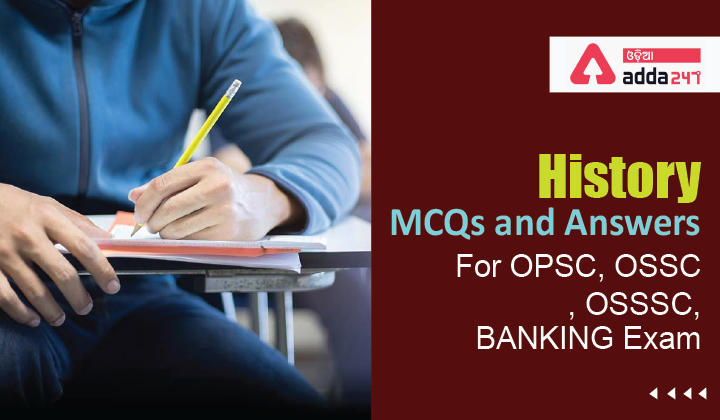History MCQs and Answers: History MCQs are very important for OPSC, OSSC, OSSSC & Other State Exams. Aspirants who are willing to apply for the various Government exams 2022 must go through the topics of History for competitive exams, as History is a key part of the syllabus.
History MCQs
Q1. Where is Muslim mosque situated where a hair of pagamber Mohammad Saheb has been preserved?
(a) Ajmer
(b) Ahmedabad
(c) Srinagar
(d) Mecca
Q2. The Mughal painting reaches its zenith during the reign of:
(a) Akbar
(b) Jahangir
(c) Shahjahan
(d) Aurangzeb
Q3. In the Maratha Empire, the Prime Minister in the council of ministers was called?
(a) Peshwa
(b) Sachiv
(c) Mantri
(d) Samanta
Q4. The battle that led to the foundation of Muslim power in India was
(a) The first battle of Tarain
(b) The second battle of Tarain
(c) The first battle of Panipat
(d) The second battle of Panipat
Q5. The famous Kohinoor diamond was produced from one of the mines in
(a) Orissa
(b) Chhota Nagpur
(c) Bijapur
(d) Golconda
Q6. Which one of the following Mughal buildings is said to possess the unique feature of being exactly equal in length and breadth?
(a) Agra Fort
(b) Red Fort
(c) Taj Mahal
(d) Buland Darwaza
Q7. The Khilji Sultans of Delhi were
(a) Mongols
(b) Afghans
(c) Turks
(d) A Jat tribe
Q8. The Qutub Minar was completed by the famous ruler
(a) Qutub-ud-din Aibak
(b) Iltutmish
(c) Babur
(d) Alauddin Khilji
Q9. During the rule of______ Ibn Batuta visited India.
(a) Iltutmish
(b) Ala-ud-din Khalji
(c) Muhammad bin Tughluq
(d) Balban
Q10. Where did Babar die?
(a) Agra
(b) Kabul
(c) Lahore
(d) Delhi
Q11. Wahabis were ________ fanatics.
(a) Hindu
(b) Muslim
(c) Christian
(d) Sikh
Q12.Who was the founder of Seva Sadan in Bombay?
(a) Shiva Narayan Agnihotri
(b) Ramabai Ranade
(c) R.G. Bhandarkar
(d) B.K. Jayakar
Q13.The Theosophical Society was founded in the U. S. A. by ?
(a)A. O. Hume
(b)Dr. Annie Besant
(c)Madam Blavatsky and Olcott
(d)Tilak and Gokhale
Q14. Consider the following statements related to Raja Ram Mohan Roy:
- He advocated widow remarriage
- He strongly advocated for the abolition of Sati system
- He advocated for the promotion of English Education
(a) only 1
(b) 1 and 2
(c) 2 and 3
(d) 1, 2 and 3
Q15. Who among the following Governor-General created the Covenanted Civil Service of India which later came to be known as the Indian Civil Service?
(a) Warren Hastings
(b) Wellesley
(c) Cornwallis
(d) William Bentinck

Solutions
S1.Ans.(c)
Sol.The Hazratbal Shrine, is a Muslim shrine in Hazratbal, Srinagar, Jammu & Kashmir. It contains a relic, the Moi-e-Muqqadas, believed by many Muslims of Kashmir to be a hair of prophet Muhammad.
S2.Ans.(b)
Sol.Jahangir had a very discriminating eye and Mughal painting reached its climax of glory during his reign.
Ans.(a)
S3.Ans(a)
Sol.A Peshwa was the equivalent of a modern Prime Minister in the Maratha Empire.
S4.Ans.(b)
Sol.The Second Battle of Tarian (Taraori) was again fought between Ghurid army of Mohammed Ghori and Rajput army of Prithviraj Chauhan. The battle took place in 1192 A.D near Tarain. In this battle, Prithviraj Chauhan was defeated by Mohammed Ghori.
S5.Ans.(d)
Sol.The famous Koh-i-Noor (“mountain of light” in Persian) diamond weights 105.60 cts and is considered one of the 5 priciest diamonds in the world was mined in Golconda, India.
S6.Ans.(c)
Sol.The Taj Mahal is an ivory-white marble mausoleum on the south bank of the Yamuna river in the Indian city of Agra. It was commissioned in 1632 by the Mughal emperor, Shah Jahan, to house the tomb of his favourite wife, Mumtaz Mahal.
S7.Ans.(c)
Sol.The Khiljis were one of the clans of the Turks. The rule of Khilji Dynasty has reached the power and influence of Delhi Sultanate to its peak. The Khilji’s were marked by wars and internal conflicts.
S8.Ans.(b)
Sol.The construction of the Qutub Minar was started by Qitub-ud-Din Aibak, but he only constructed the basement. The construction of the tower was later taken over by his successor Iltutmish who constructed three more stories.
S9.Ans.(c)
Sol.After his third pilgrimage to Mecca, Ibn Battuta decided to seek employment with the Muslim Sultan of Delhi, Muhammad bin Tughluq. In the autumn of 1330 (or 1332), he set off for the Seljuk controlled territory of Anatolia with the intention of taking an overland route to India.
S10.Ans.(a)
Sol.Babur died in 1530 and was succeeded by Humayun. According to Babur’s wishes, he was buried in Bagh-e-Babur in Kabul, Afghanistan
S11.Ans.(b)
Sol. Wahhabism is an Islamic doctrine and religious movement founded by Muhammad ibn Abd al-Wahhab. It has been variously described as an Islamic “reform movement” to restore “pure monotheistic worship” by devotees.
S12.Ans.(b)
Sol. Ramabai Ranade was a pioneer of the modern women’s movement in India and outside. She was the founder and president of the “Seva Sadan”, which is the most successful of all Indian women’s institution and is attended by thousands of women.
S13.Ans.(c)
Sol. The Theosophical Society was officially formed in New York City, United States, on 17 November 1875 by Helena Petrovna Blavatsky, Colonel Henry Steel Olcott, William Quan Judge, and others. It was self-described as an unsectarian body of seekers after Truth, who endeavour to promote Brotherhood and strive to serve humanity.
S14.Ans.(d)
Sol. Raja Ram Mohan was the founder of the Brahmo Sabha movement in 1828, which engendered the Brahmo Samaj, an influential socio-religious reform movement.His influence was apparent in the fields of politics, public administration and education as well as religion. He was known for his efforts to establish the abolishment of the practice of sati.
S15.Ans.(c)
Sol. The civil services were reformed and modernised by Lord Cornwallis and hence he is called the “Father of Indian Civil Service”.














